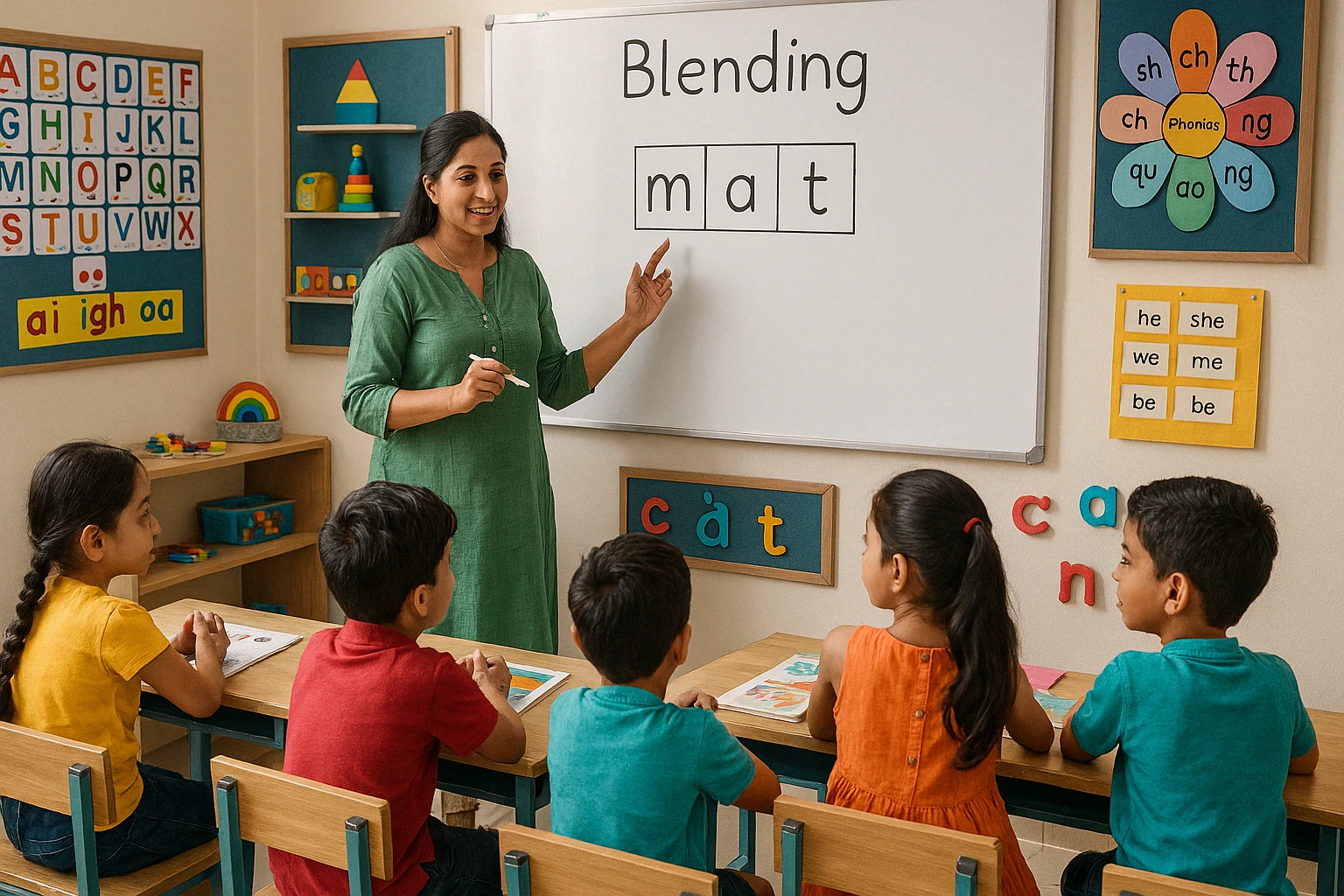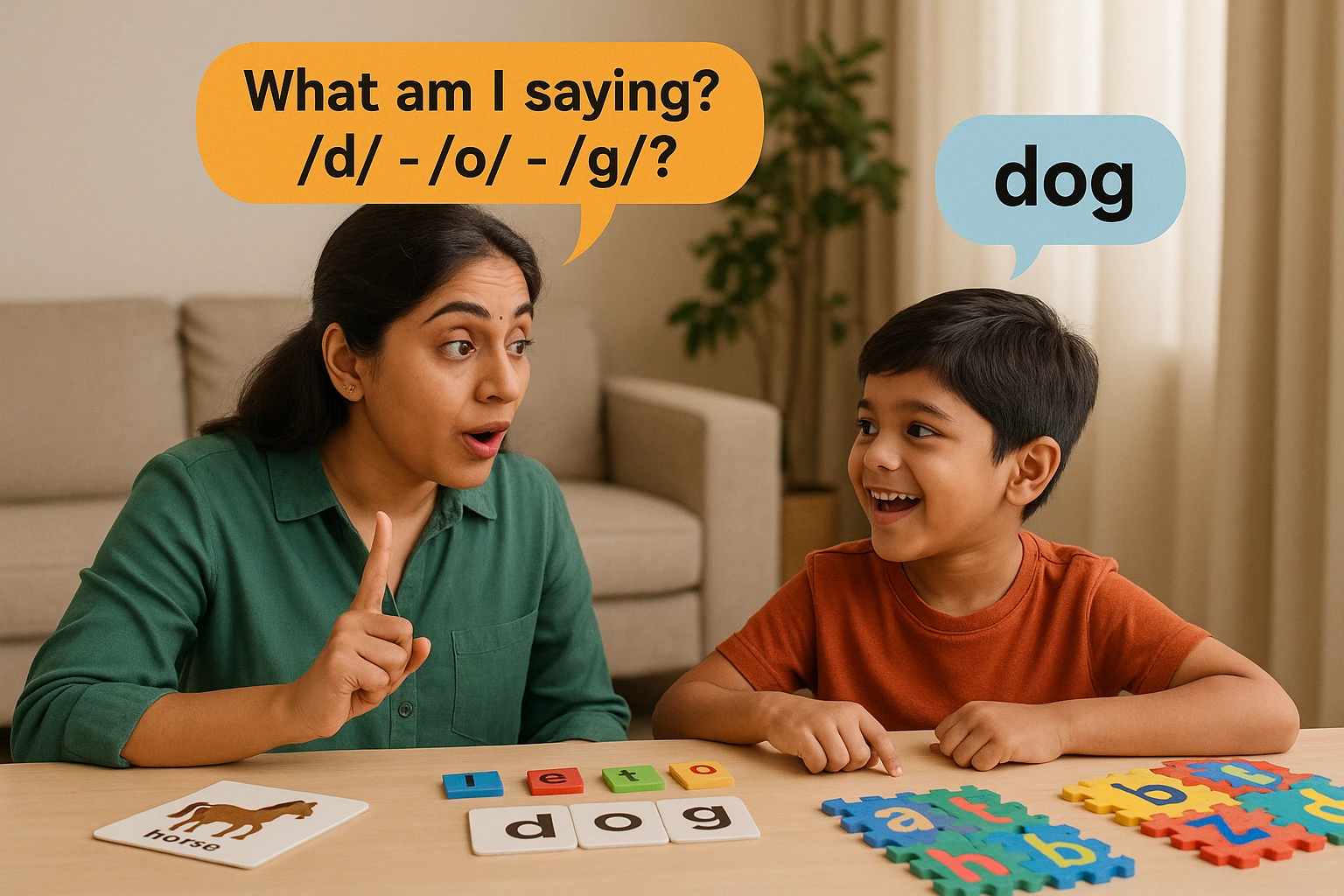Phonics Reading Practice for Beginners
Phonics Reading Practice for Beginners
Phonics is the key to reading success, particularly for those just beginning their journey with words. It helps beginners associate letters with their sounds, building a robust base for reading and writing. Phonics Reading Practice plays a key role in making this connection clear and effective.
Through regular Reading Practice for Beginners, children learn to recognize patterns, improve pronunciation, and grow confident in reading. This blog will highlight simple ways to include Phonics Reading Practice in early learning to support steady progress.
Table of Content
Phonics and Early Reading Practice Guide
The Phonics and Early Reading Practice Guide is one of the excellent means to support children in becoming successful readers. It focuses on familiarizing the connection between letters and their related sounds, facilitating learners to interpret words and read with confidence. Through this guide, you will understand two essential building blocks—phonemic awareness and comprehension of letters and sounds—and their role in effective reading Practice.
Comprehending Phonemic Awareness
Phonemic awareness is the expertness to listen, identify, and use individual sounds (phonemes) in articulated words. It is a listening talent that trains children for later phonics instruction.
Key elements include:
Sound Identification
Children learn to recognize sounds at the beginning, middle, and end of words. For example, hearing the /c/ sound in “cat.”
Sound Isolation
Splitting down words into respective sounds helps learners develop more robust auditory skills. For instance, identifying the three separate sounds in “tub” – /t/, /u/, /b/.
Blending and Segmenting
Children practice combining sounds to form words and segmenting words into their constituent sounds. This skill directly supports Phonics Reading Practice by building word recognition from the ground up.
Phonemic awareness does not interest letters at first; it concentrates purely on sounds. However, it lays the groundwork for relating sounds with written characters during reading.
Learning the Relationship between Letters and Sounds
After the establishment of phonemic awareness, children are prepared to master letter-sound connections. This is the heart of phonics pedagogy and paramount to effective reading practice.
Here’s how it functions:
Letter Identification
Children learn to determine letters of the alphabet, both uppercase and lowercase.
Sound Association
Each letter is related to its most common sound. For example, “d” is related to the /d/ sound. Routine reading practice helps strengthen this association.
Decoding Words
Children can effortlessly read unfamiliar words by voicing out each letter in a word and merging the sounds together.
Vocabulary Expansion
As children immerse in Reading Practice, they develop a growing word bank that advocates reading mastery and comprehension.
Techniques for Effective Reading Practice:
- Use brief, daily sessions to keep learners immersed.
- Start with easy consonant-vowel-consonant (CVC) words.
- Incorporate visual resources, letter tiles, sound cards, etc.
- Practice reading aloud using phonics-based readers.
Children are set on an explicit path to reading mastery by building a robust base in phonemic awareness and grasping the connection between letters and sounds. Routine Phonics Reading Practice ensures the creation of confident and capable readers from the very start.
For downloading the brochure of Phonics Course, Click Here!
Call or Whatsapp on +918104606573 / +919869546913, for the details of Phonics Course!

Phonemic Awareness Includes
Phonemic awareness is the mastery to hear, identify, and use individual sounds—known as phonemes—in uttered words. With a robust understanding of phonemic awareness, learners can interpret new words confidently.
Here’s what Phonemic Awareness Includes, with each topic playing a vital part in early reading expansion:
Sound Isolation
- Children learn to recognize distinct letter sounds at the start, middle, or end of a word. For instance, the word ‘lid’ starts with the /l/ sound, the middle sound is /i/, and it ends with the /d/ sound.
- This skill trains the brain to map sounds to letters, which is a vital element of reading practice.
- It also builds early spelling skills by helping children understand sound placement.
Sound Blending
- Blending involves merging respective phonemes to form a word. For instance, putting together /f/, /u/, and /n/ creates the word fun.
- Blending, during Phonics Reading Practice, teaches children to interpret unfamiliar words without guidance.
- It supports efficient reading and helps build fluency from the start.
Sound Segmentation
- Segmentation is the opposite of blending. It interests splitting a word down into its distinct sounds. For instance, the word flop can be split into /fl/, /o/, and /p/.
- Segmentation strengthens spelling mastery as it encourages children to listen carefully to every sound.
- In Phonics Reading Practice, this activity helps learners recognize letter-sound correspondence more accurately.
Sound Addition and Deletion
- These skills involve adding or removing a sound in a word to create a new one. For example, adding /s/ to the word top creates stop. Removing /s/ from stop brings it back to top.
- This activity strengthens flexible thinking around words.
- It also enhances problem-solving during phonics practice, as learners experiment with how sounds influence word formation.
Sound Substitution
- Here, one sound is replaced with another to form a new word. For instance, replacing the /r/ in rat with /f/ turns the word into fat.
- Substitution expands phoneme recognition and manipulation mastery.
- It encourages learners to engage actively during reading practice, boosting both confidence and vocabulary.
Rhyming and Alliteration
- Acknowledging rhyming words or recognizing words starting with the same sound is one of the fantastic ways to build awareness of sound structure.
- Rhyming boosts auditory differentiation and remembrance.
- Alliteration practice during reading practice supports sound recognition in different contexts.
Phonemic Awareness Includes activities that are important in establishing the stage for thriving Phonics Reading Practice. By concentrating on these vital elements of phonics, early readers acquire the confidence and proficiency to read with excellent fluency and familiarity.
For downloading the brochure of Phonics Course, Click Here!
Call or Whatsapp on +918104606573 / +919869546913, for the details of Phonics Course!

Source: shutterstock
Building Confidence through Repetitive Practice
Confidence is one of the most significant outcomes of Phonics Reading Practice. For newbies, learning to read can feel demanding, but practice offers a systematic way to build skills steadily. Repetition helps children master sounds, identify patterns, and become more eloquent readers over time.
Below are the key ways repetitive practice supports reading development and boosts confidence in young learners:
Creates a Safe Space for Learning
- When children are involved in reading practice regularly, they start to feel comfortable with the learning process.
- Repeating the same sound patterns and word formats allows them to practice without the dread of failure.
- This repeated exposure gives children the courage to try reading new words using what they’ve already learned.
- Repetition helps reduce anxiety linked to new tasks.
- Familiarity leads to a sense of control, which helps in Building Confidence through Repetitive Practice and trust in their own ability.
- With frequent practice, children know what to expect and how to respond.
Supports Sound and Letter Recognition
- As Phonics largely depends on sounds and their matching letters, beginners often need to review the same sounds multiple times before advancing with intricate phonics concepts.
- Repeating consonant-vowel-consonant words supports sound blending.
- Reading Practice allows these associations to adhere by engrossing the brain in repeated retrieval.
- With each repetition, children decode more quickly and accurately.
Encourages Independent Reading
- As learners build their pool of familiar sounds and words, they grow more confident in reading short sentences on their own.
- Repetitive reading of phonics-based contexts helps children move from guided reading to self-sustaining practice.
- Short, repeated passages or stories support fluency.
- Sight words become easier to recognize through Phonics Practice.
- Independent reading boosts self-esteem and strengthens motivation to read more.
Builds Memory and Automaticity
- Automaticity in reading means acknowledging sounds and words without deliberate effort.
- This is crucial for mastery and comprehension, and repetitive phonics work is a significant driver of it.
- The brain needs multiple exposures to store information in long-term memory.
- Repeated Phonics Practice trains the brain to access word patterns quickly.
- This smooth recall allows learners to focus on meaning rather than just decoding.
Fosters a Growth Mindset
- Repetition strengthens understanding and also enlightens learners that progress comes with practice.
- It builds faith in their ability to flourish every time a child learns a new sound or reads a tricky word correctly.
- Children begin to view mistakes as part of learning.
- Phonics Practice sets achievable goals, offering small wins along the way.
- Advancement through repetition leads to a strong internal stimulation to keep learning.
By focusing on routine revision through integrated Phonics Reading Practice, educators and parents can help children develop robust reading skills and long-lasting confidence. This approach not only supports skill development but also nurtures an optimistic attitude toward learning to read.
For downloading the brochure of Phonics Course, Click Here!
Call or Whatsapp on +918104606573 / +919869546913, for the details of Phonics Course!

Certification in Phonics
Strong foundational literacy skills begin with Phonics Reading Practice, and to deliver that effectively, educators need the right training. Vidhyanidhi Education Society (Govt. Regd.) offers a Certification in Phonics designed to meet the needs of a wide range of individuals—whether you’re just starting or looking to build on your existing skills. This course equips you with practical knowledge, techniques, and tools to support Phonics Practice in any learning setting.
Here’s how this Certification in Phonics Course can benefit different learner profiles:
Aspiring Teachers
If you’re looking to enter a teaching profession, this Certification in Phonics gives you a substantial grounding in early literacy teaching. It helps you learn how to make Phonics Practice fun and effective for young learners, uplifting your job readiness and employability in schools and tuition hubs.
Current Teachers
Already teaching but feel your phonics skills need sharpening? This course offers updated methods and strategies aligned with modern classroom needs. You’ll learn how to deliver targeted Phonics Practice sessions that improve reading fluency and comprehension in your students.
Tutors
Private tutors can benefit greatly from this course. You’ll learn techniques that help children decipher words accurately, support spelling advancement, and build writing mastery. Phonics Practice becomes easier to adapt across different age groups and learning levels after achieving the Certification in Phonics.
Women Entrepreneurs
If you’re running or preparing to start an academic setup or activity center, the Certification in Phonics prepares you to offer structured and result-oriented phonics classes. This adds value to your services and builds credibility among parents looking for effective reading support.
Mothers
For parents, primarily mothers who want to play a dynamic role in their child’s education, this Certification in Phonics Course provides means to familiarize Phonics Practice at home. It helps improve your child’s reading habits and builds a strong English language foundation without external dependency.
Beginners in Education
If you’re fresh to the education domain, this is an excellent starting point. With no preliminary teaching background needed, the Certification in Phonics allows you to gain an invaluable skill that can be used in countless career pathways, including part-time or freelance teaching positions.
Mid-Career Professionals
Those looking to shift from a corporate or unrelated field into education will find this course useful. It opens doors to part-time teaching, phonics tutoring, or even launching your own phonics learning modules. Phonics Reading Practice sessions can be offered in-person or online, allowing for flexible work schedules.
This course is structured to meet varied needs while keeping the learner at the center. With a focus on practical application and child-friendly techniques, the Certification in Phonics from Vidhyanidhi Education Society (Govt. Regd.) prepares you to deliver effective, engaging Phonics Reading Practice in real-world teaching situations.
Boost young readers’ skills—join Vidhyanidhi’s Phonics Course today!
For downloading the brochure of Phonics Course, Click Here!
Call or Whatsapp on +918104606573 / +919869546913, for the details of Phonics Course!
FAQs
How often should Phonics Practice be done?
For beginners, short and consistent practice sessions—10 to 15 minutes daily—are more effective than longer sessions done occasionally.
Should Phonics be taught in a Specific Order?
Yes, it’s ideal to start with simple consonant and vowel sounds, then move to blending, digraphs, and eventually more complex patterns.





